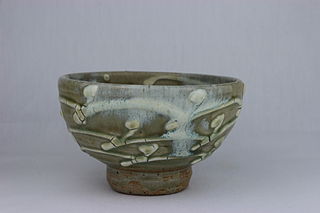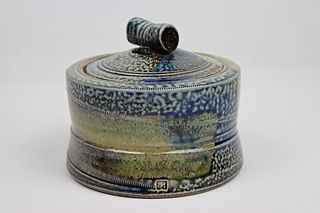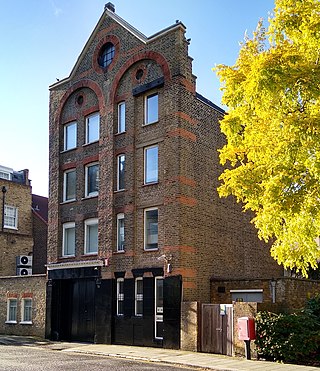
MIMA, or Middlesbrough Institute of Modern Art, is a contemporary art gallery based in the centre of Middlesbrough, England. The gallery was formally launched on Sunday, 27 January 2007; since 2014, it has been part of Teesside University.

Shōji Hamada was a Japanese potter. He had a significant influence on studio pottery of the twentieth century, and a major figure of the mingei (folk-art) movement, establishing the town of Mashiko as a world-renowned pottery centre. In 1955 he was designated a "Living National Treasure".

Studio pottery is pottery made by professional and amateur artists or artisans working alone or in small groups, making unique items or short runs. Typically, all stages of manufacture are carried out by the artists themselves. Studio pottery includes functional wares such as tableware and cookware, and non-functional wares such as sculpture, with vases and bowls covering the middle ground, often being used only for display. Studio potters can be referred to as ceramic artists, ceramists, ceramicists or as an artist who uses clay as a medium.
D. Wayne Higby is an American artist working in ceramics. The American Craft Museum considers him a "visionary of the American Crafts Movement" and recognized him as one of seven artists who are "genuine living legends representing the best of American artists in their chosen medium."
Dora May Billington (1890–1968) was an English teacher of pottery, a writer and a studio potter. Her own work explored the possibilities of painting on pottery.

Takeshi Yasuda is a Japanese potter who was born in Tokyo, Japan, in 1943. Yasuda trained at the Daisei-Kiln in Mashiko from 1963 to 1966 and established his first studio there. His early work consisted of ash-glazed stoneware, after which he explored sancai and creamware. Most recently Yasuda has been working with celadon-glazed porcelain.
Robert Prime was a gallery in London in the late 1990s. Founded by Tommaso Corvi-Mora and Gregorio Magnani, it held the first exhibitions in London of artists including Dominique Gonzalez-Foerster, Isa Genzken, Philippe Parreno and General Idea. It also hosted the first exhibitions of artists including Rachel Feinstein, Martin Maloney, Vydia Galstaldon and Jean-Michel Wicker. The gallery closed in December 1999.

Edmund Arthur Lowndes de Waal, is a contemporary English artist, master potter and author. He is known for his large-scale installations of porcelain vessels often created in response to collections and archives or the history of a particular place. De Waal's book The Hare with Amber Eyes was awarded the Costa Book Award for Biography, Royal Society of Literature Ondaatje Prize in 2011 and Windham–Campbell Literature Prize for Non-Fiction in 2015. De Waal's second book The White Road, tracing his journey to discover the history of porcelain was released in 2015.

Elizabeth Fritsch CBE is a British studio potter and ceramic artist born into a Welsh family in Whitchurch on the Shropshire border. Her innovative hand built and painted pots are often influenced by ideas from music, painting, literature, landscape and architecture.
Jack Doherty is a Northern Irish studio potter and author. He is perhaps best known for his vessels made of soda-fired porcelain. He has been featured in a number of books, and his work has been exhibited widely in both Europe and North America. Articles of his have appeared in various pottery journals and he has been Chair of the Craft Potters Association.

Jane Hamlyn is an English studio potter known for her functional salt glaze pottery.
Garth Clark is an art critic, art historian, curator, gallerist, and art dealer from Pretoria, South Africa.
Clare Twomey is a London-based visual artist, curator and researcher, working in performance, serial production, and site-specific installation. Her practice encompasses site-specific installation and performance; she frequently collaborates with institutions, enouraging participation and temporality.

Stephen Dixon is a British ceramic artist and Professor Emeritus at Manchester School of Art. He is also a satirist, writer, lecturer and curator. He is known mainly for his use of dark narrative and for using "illustrated ceramics pots as an unlikely platform for social commentary and political discontent." From Renaissance paintings and British politics to pop culture, Dixon draws on a variety of sources to "challenge the status quo and inspire new ways of thinking." His interests include the British satirical tradition, commemorative wares, and the development of socio-political narratives in contemporary ceramics. In 2021 Dixon was awarded the prestigious British Ceramics Biennial AWARD for his installation 'The Ship of Dreams and Nightmares'.

Donald Lester Reitz was an American ceramic artist, recognized for inspiring a reemergence of salt glaze pottery in United States. He was a teacher of ceramic art at the University of Wisconsin–Madison from 1962 until 1988. During this period, he adapted the pottery firing technique developed in the Middle Ages, which involved pouring salt into the pottery kiln during the firing stage. The method was taught in European ceramic art schools, but largely unknown in United States studio pottery.

Corvi-Mora is a contemporary art gallery based in Kennington, South London. The gallery represents emerging and established international artists including Turner Prize nominees Roger Hiorns and Lynette Yiadom-Boakye.

Denise Wren was an Australian-born British studio potter and craftsperson. Wren was one of the first female studio potters in Britain. She studied and taught with the Kingston School of Art, Knox Guild and Camberwell College of Arts. Wren and her family subsequently set up the Oxshott Pottery and wrote on the subjects of ceramics, textiles and making.

Jennifer Elizabeth Lee is a Scottish ceramic artist with an international reputation. Lee's distinctive pots are hand built using traditional pinch and coil methods. She has developed a method of colouring the pots by mixing metallic oxides into the clay before making. Her work is held in over forty museums and public collections worldwide, including the Metropolitan Museum of Art in New York, the Philadelphia Museum of Art, the Los Angeles County Museum and the Victoria and Albert Museum. In 2018 Lee won the Loewe Craft Prize, an award initiated by Jonathan Anderson in 2017. The prize was presented to her at an awards ceremony at The Design Museum in London.
Sandy Brown is a British ceramics artist who is nationally and internationally known for her works, which range from smaller ceramics to huge public sculptures. Brown is a Fellow of the Craft Potters Association.
Anders Herwald Ruhwald is a Danish-American sculptor. He works primarily in clay, a medium he has been drawn to since he was 15. Ruhwald's work blends references from functional objects to classical sculpture and can take the form of singular objects as well as immersive installations












